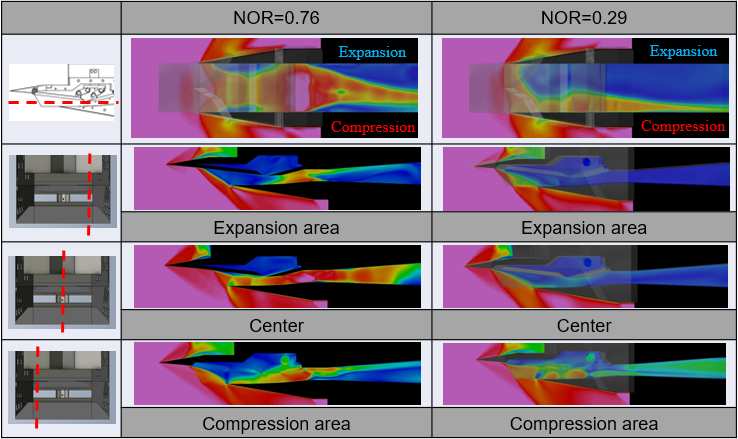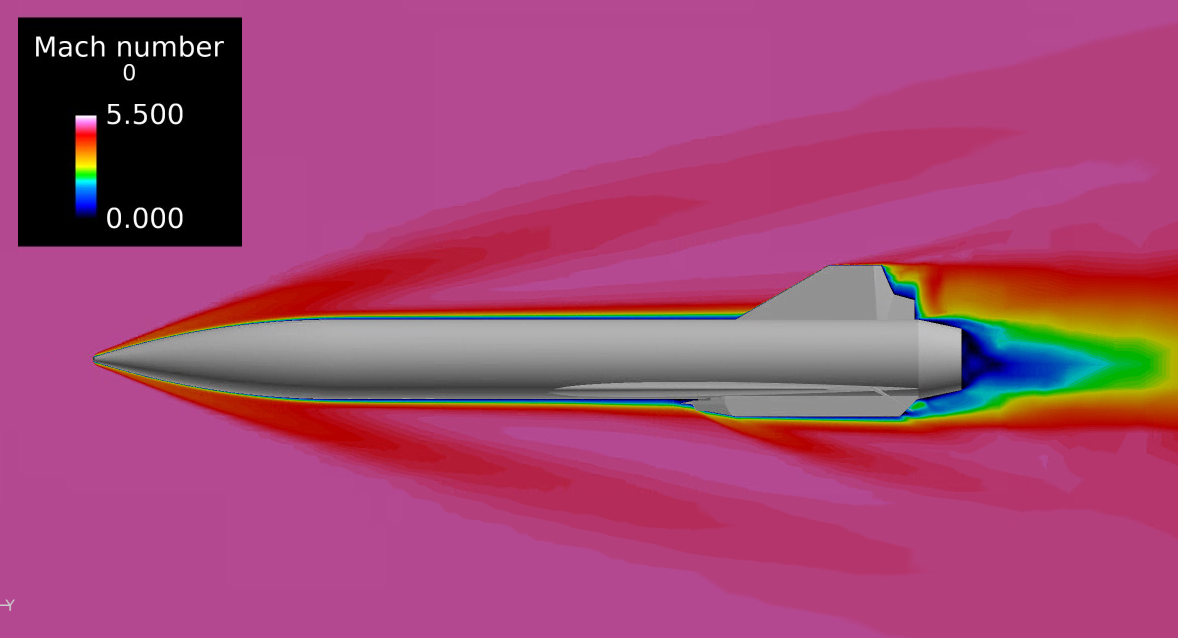Hydrogen Application to Aircraft and Future Space Transportation System
JAXA Supercomputer System Annual Report February 2023-January 2024
Report Number: R23EA2121
Subject Category: Aeronautical Technology
- Responsible Representative: Sadatake Tomioka, Leader, Hydrogen Aerospace Plane Team
- Contact Information: Hideyuki Taguchi(taguchi.hideyuki@jaxa.jp)
- Members: Koichi Omi, Manami Fujii, Yuki Kuwabara, Rintaro Tanaka, Koutarou Nakayama, Shota Kiuchi, Nozomi Takaki, Shima Ariyoshi, Aoto Kikui, Kaito Hirose, Ryo Yoshida, Shunsuke Takamatsu, Tomofumi Narita, Shinji Nakaya, Masafumi Momose, Taisuke Nambu, Naoyuki Okamura, Junichi Oki, Shunsuke Imamura, Motoyuki Hongoh, Hideyuki Taguchi
Abstract
This research aims at the demonstration of the thrust control method of a hypersonic pre-cooled turbojet engine using liquid hydrogen fuel and the aircraft / propulsion integrated control method. We acquire the control characteristics of the hypersonic integrated control experimental aircraft to establish the aircraft / propulsion integrated control method taking into account the mutual interference of hypersonic airframe and hypersonic engines. In addition to defining the required specifications of hypersonic aircraft, we present the design specifications of the hypersonic experimental aircraft for carrying out flight demonstration of hypersonic pre-cooled turbojet engine.
Reference URL
Please refer to https://www.ard.jaxa.jp/eng/research/hydrogenfuel/hydrogenfuel.html .
Reasons and benefits of using JAXA Supercomputer System
We need a long calcularion time to obtain the aerodynamic characteristics of the overall hypersonic experimental aircraft by CFD analyses.
For reacting flow simulation including NOx, there are many chemical species and calculation cost is high.
Achievements of the Year
CFD was conducted to investigate on the characteristics of the side slip angle for the model of High-Mach Integrated Control Experiment (HIMICO). (Fig. 1)
CFD was used to evaluate the aerodynamic characteristics of the High-Mach Integrated Control Experimental Aircraft with the angled elevons and rudder (Fig.2).
LES of combustion inside the model afterburner of pre-cooled turbojet engine under lean and rich conditions. (Fig. 3)
CFD was conducted to evaluate the performance of the intake for a combined cycle engine during intake switching. (Fig. 4)
Publications
– Oral Presentations
Yuki Kuwabara, Manami Fujii, Yuki Fujimori, Yusuke Hoshiya, Rintaro Tanaka, Shima Ariyoshi, Ayuto Suzuki, Tetsuya Sato, Hidemi Takahashi, Hideyuki Taguchi, Experimental and Numerical Investigation of the Sideslip Angle on the Ramjet Intake for High Mach Integrated Control Experiment (HIMICO) Model at Mach 2, 34th International Symposium on Space Technology and Science (ISTS), 2023
Shota Kiuchi, Tomonari Hirotani, Hidemi Takahashi, Hideyuki Taguchi, Asei Tezuka, Effect of mutual aerodynamic interferences on steering characteristics of High-Mach Integrated Control Experiment (HIMICO) Vehicle, 2023 Symposium on Flight Mechanics and Astrodynamics, 2023
Kotaro Nakayama, Koichi Omi, Kaito Hirose (University of Tokyo), Hideyuki Taguchi (JAXA), Kengo Takizawa, Shinji Nakaya, Mitsuhiro Tsue(University of Tokyo) “A Study on NOx Emissions in Hydrogen Ram Combustion under Lean and Rich Conditions”, Proceedings of the Conference on Aerospace Propulsion, 2024
Rintaro Tanaka, Manami Fuji, Shima Ariyoshi, Shunsuke Takamatsu, Tetsuya Sato (Waseda University), Hidemi Takahashi, Tomonari Hirotani, Hideyuki Taguchi, Sadatake Tomioka (JAXA), “Aerodynamic design of intakes for turbo-ram/scram combined cycle engines and evaluation of performance during operation mode switching” , Proceedings of the Conference on Aerospace Propulsion, 2024
Usage of JSS
Computational Information
- Process Parallelization Methods: MPI
- Thread Parallelization Methods: OpenMP
- Number of Processes: 1 – 2
- Elapsed Time per Case: 30 Hour(s)
JSS3 Resources Used
Fraction of Usage in Total Resources*1(%): 1.52
Details
Please refer to System Configuration of JSS3 for the system configuration and major specifications of JSS3.
| System Name | CPU Resources Used(Core x Hours) | Fraction of Usage*2(%) |
|---|---|---|
| TOKI-SORA | 36820036.43 | 1.66 |
| TOKI-ST | 1109947.85 | 1.20 |
| TOKI-GP | 0.37 | 0.00 |
| TOKI-XM | 0.00 | 0.00 |
| TOKI-LM | 79.65 | 0.01 |
| TOKI-TST | 0.00 | 0.00 |
| TOKI-TGP | 0.00 | 0.00 |
| TOKI-TLM | 0.00 | 0.00 |
| File System Name | Storage Assigned(GiB) | Fraction of Usage*2(%) |
|---|---|---|
| /home | 1485.79 | 1.23 |
| /data and /data2 | 426698.25 | 2.63 |
| /ssd | 9160.88 | 0.87 |
| Archiver Name | Storage Used(TiB) | Fraction of Usage*2(%) |
|---|---|---|
| J-SPACE | 13.75 | 0.05 |
*1: Fraction of Usage in Total Resources: Weighted average of three resource types (Computing, File System, and Archiver).
*2: Fraction of Usage:Percentage of usage relative to each resource used in one year.
ISV Software Licenses Used
| ISV Software Licenses Used(Hours) | Fraction of Usage*2(%) | |
|---|---|---|
| ISV Software Licenses(Total) | 4652.71 | 2.10 |
*2: Fraction of Usage:Percentage of usage relative to each resource used in one year.
JAXA Supercomputer System Annual Report February 2023-January 2024






